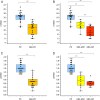Unraveling Autonomic Dysfunction in GBA-Related Parkinson's Disease
- PMID: 38026514
- PMCID: PMC10654845
- DOI: 10.1002/mdc3.13892
Unraveling Autonomic Dysfunction in GBA-Related Parkinson's Disease
Abstract
Background: Patients with Parkinson's disease (PD) and GBA gene mutations (GBA-PD) develop nonmotor complications more frequently than noncarriers. However, an objective characterization of both cardiovascular and sudomotor autonomic dysfunction using extensive clinical and instrumental measures has never been provided so far. Survival is reduced in GBA-PD regardless of age and dementia, suggesting that other hitherto unrecognized factors are involved.
Objectives: To provide instrumental measures of pattern and severity of autonomic dysfunction in GBA-PD and explore their correlation with other non-motor symptoms and implications for clinical practice.
Methods: In this cross-sectional study, 21 GBA-PD and 24 matched PD noncarriers underwent extensive assessment of motor and non-motor features, including neuropsychological testing. Cardiovascular autonomic function was explored through a comprehensive battery of indexes, including power spectral analysis of the R-R intervals and blood pressure short-term variability during resting state and active maneuvers. Dynamic Sweat Test was used to assess post-ganglionic sudomotor dysfunction.
Results: Despite minimal or absent clinical correlates, cardiovagal and sympathetic indexes, heart rate variability parameters and sudomotor postganglionic function were more severely impaired in GBA-PD than noncarriers (overcoming relatively preserved compensatory peripheral sympathetic function), suggesting more prominent cardiac sympatho-vagal demodulation, efferent baroreflex failure and peripheral sympathetic dysfunction in GBA-PD. Cardiovascular dysautonomia showed marginal correlations with cognitive impairment.
Conclusions: Compared to PD noncarriers, GBA-PD display more severe instrumental autonomic abnormalities, which may be underestimated by purely clinical measures, despite their relevance on morbidity and mortality. This supports the necessity of implementing instrumental autonomic assessment in all GBA-PD, regardless of clinically overt symptoms.
Keywords: GBA; Parkinson's disease; autonomic dysfunction; spectral analysis; sudomotor dysfunction.
© 2023 The Authors. Movement Disorders Clinical Practice published by Wiley Periodicals LLC on behalf of International Parkinson and Movement Disorder Society.
Figures

References
-
- Cilia R, Tunesi S, Marotta G, et al. Survival and dementia in GBA‐associated Parkinson's disease: the mutation matters. Ann Neurol 2016;80:662–673. - PubMed
-
- Petrucci S, Ginevrino M, Trezzi I, et al. GBA‐related Parkinson's disease: dissection of genotype‐phenotype correlates in a large Italian cohort. Mov Disord 2020;35:2106–2111. - PubMed
LinkOut - more resources
Full Text Sources

